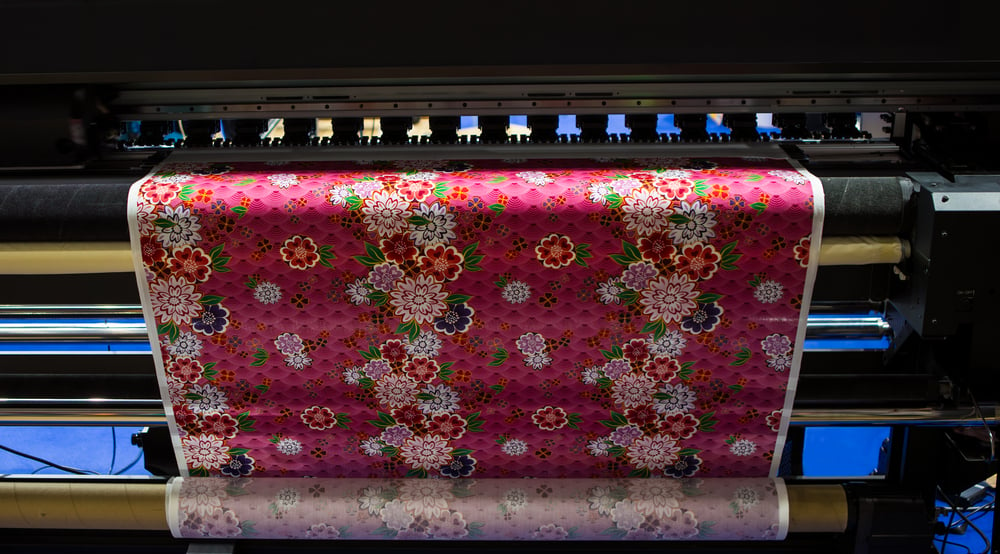A Comprehensive Overview to the Different Kinds Of Cloth Printing Strategies
Getting started on an expedition of fabric printing strategies discloses an interesting intersection of custom and development. Each approach, from the precise craftsmanship of block printing to the rapid efficiency of display printing, offers distinct objectives and offers unique benefits. Digital printing's versatility and ecological awareness stand in raw comparison to the swift personalization of warm transfer printing. At the same time, color sublimation printing captivates with its capability to generate vibrant, long-lasting layouts on synthetic materials. To genuinely comprehend the subtleties and potential applications of these diverse strategies, a deeper investigation is important.
Block Printing
Block Printing, among the earliest methods of fabric decoration, has an abundant history that goes back to ancient people. Coming from China around 220 A.D., this strategy later on infected India and eventually Europe. The process involves sculpting complex designs right into wood blocks, which are then dipped in color and pressed onto material to develop patterns. This method is significant for its capacity to generate extremely described and recurring designs.
The accuracy and craftsmanship associated with block printing make it a labor-intensive procedure, however it additionally permits a high degree of customization. Artisans can create special patterns by incorporating various blocks or differing the application of color. This flexibility has contributed to the enduring appeal of block printing in both typical and modern textile style.
Block printing is especially valued for its visual high qualities, including the mild variations in pattern and color that arise from the hand-printing process. These blemishes provide an one-of-a-kind character to every piece, differentiating it from mass-produced textiles. Regardless of developments in modern printing innovations, block printing continues to be a cherished strategy, commemorated for its historic importance and artistic value.
Display Printing
Display printing, one more noticeable fabric design strategy, has changed the industry with its performance and versatility. This method includes developing a stencil, called a screen, and using it to use layers of ink on the printing surface. Each shade in the style needs a different screen, which enables vibrant and complex multi-colored prints.

Among the vital benefits of screen printing is its adaptability to various sorts of textiles, consisting of cotton, polyester, and blends. This technique is particularly appropriate for large-volume orders because of its cost-effectiveness and rate. The resilience of the prints is another substantial benefit, as the ink bonds well with the material, making certain durable layouts that hold up against numerous cleans.
As soon as dried out, the layout is transferred onto the emulsion-coated display using a UV light source. Ink is after that pushed via the stencil onto the textile making use of a squeegee.
Display printing is widely utilized in the garment industry, advertising products, and custom-made garments. Its ability for high-quality, thorough prints protects its status as a cornerstone strategy in textile printing.
Digital Printing
Digital printing has quickly arised as a sophisticated method in the textile market, leveraging advanced technology to create high-resolution designs straight onto fabric. Unlike traditional techniques, electronic printing utilizes inkjet recommended you read printers to deposit pigment or dye-based inks onto fabrics, enabling vivid and detailed patterns with an impressive degree of detail and color Check This Out precision.
One of the main benefits of electronic printing is its versatility. This approach allows for on-demand printing, which considerably decreases waste and minimizes stock costs.
Furthermore, electronic printing is eco-friendly. heat transfer vinyl printing. It uses water-based inks and calls for much less water and power compared to conventional methods, lining up with lasting practices. The precision of electronic printing also allows the use of a wider variety of materials, including cotton, silk, polyester, and blends, making certain adaptability throughout numerous applications
Warm Transfer Printing
Exactly how does warm transfer printing transform textile layout? Warm transfer printing includes using warm and stress to transfer a design from a specifically created paper onto material.
Among the primary advantages of warm transfer printing is its capacity to produce top quality, comprehensive images swiftly and effectively. It is particularly fit for tiny production runs and customized orders, making it a prominent choice for individualized clothing and marketing items. In addition, this method is flexible, fitting different kinds of textiles including cotton, polyester, and blends.
In addition, warmth transfer printing is fairly cost-efficient compared to other approaches, as it calls for very little setup and reduced first financial investment - DTF printing. This affordability, coupled with its capability for creating vibrant, durable prints, underscores its critical function in modern fabric layout

Dye Sublimation Printing
Dye sublimation printing, a sophisticated fabric printing method, provides unmatched vibrancy and durability for layouts on different artificial fabrics. The printed transfer paper is after that positioned on the textile, and both are subjected to high warmth and stress utilizing a heat press.
One of the vital benefits of color sublimation printing is its capability to generate continuous-tone prints with vivid colors and intricate details. Unlike other printing approaches, the color ends up being part of the fabric instead than resting on top of it, resulting in a soft and breathable surface.
Conclusion
Block printing is revered for its artisanal top quality, while screen printing is useful for click here for more high-volume production. Digital printing provides adaptability and environmental advantages, whereas warmth transfer printing is suitable for fast modification.
Each technique, from the thorough workmanship of block printing to the fast effectiveness of screen printing, serves one-of-a-kind purposes and offers unique benefits. Digital printing's versatility and ecological consciousness stand in stark contrast to the speedy modification of warmth transfer printing. Despite advancements in contemporary printing modern technologies, obstruct printing remains a treasured method, commemorated for its historic significance and artistic worth.
Dye sublimation printing, an innovative material printing method, offers unparalleled vibrancy and longevity for styles on different synthetic materials. Digital printing gives versatility and environmental advantages, whereas warm transfer printing is optimal for fast personalization.